Costa Rica is a haven for birders, boasting some of the highest bird biodiversity in the world. With over 850 species of birds, Costa Rica is home to a wide variety of colorful and unique birds, from hummingbirds and toucans to parrots and macaws.
You will find various feathered friends when visiting the rainforest, cloud, or dry forest. Costa Rica is a paradise for bird lovers, from the majestic Resplendent Quetzal to the dazzling Scarlet Macaw.
48 Costa Rica Birds
Costa Rica is a small country in Central America, but it has a vast diversity of birds. With over 850 species of birds, Costa Rica is one of the best places in the world for birdwatching.
Whether a beginner or an expert, you will find many colorful and unique birds to admire and photograph. I will introduce you to 48 Costa Rica birds you should not miss when visiting this fantastic country.
1. Resplendent Quetzal
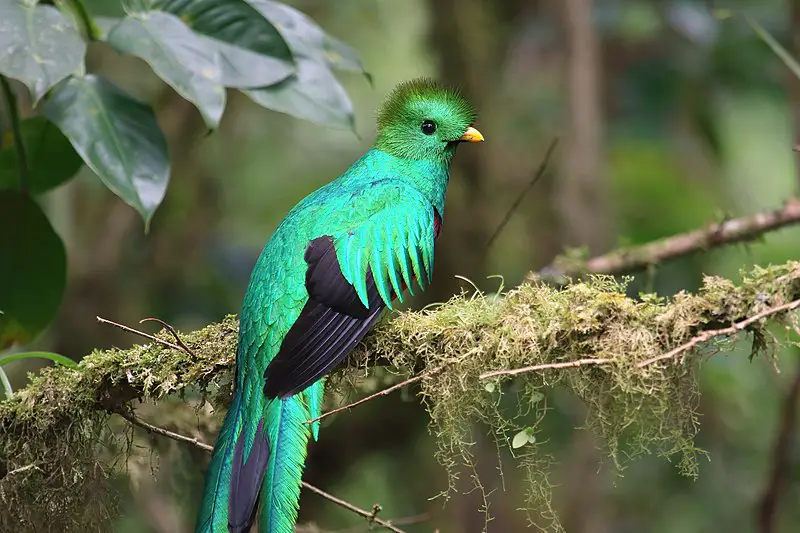
The resplendent quetzal is a beautiful and vibrant bird found in Central America. It belongs to the family Trogonidae, which includes birds like trogons and motmots.
This species of quetzal has two recognized subspecies, P. mocinno, and P. costaricensis, both living in tropical forests such as montane cloud forests.
They are omnivores, typically eating fruits from various plants, insects, lizards, or eggs when available.
The male’s plumage is particularly striking, with its multi-colored feathers ranging from green to blue to red, giving it its namesake “resplendence” look.
This coloration comes at a price for males because their bright colors make them more visible predators than females, who have duller brown coloring.
Regardless of gender, though, all members of this species demonstrate great agility in flight due to their long tails, which help stabilize them even through tight turns.
Scientific classification:
| Kingdom | Animalia |
| Phylum | Chordata |
| Class | Aves |
| Order | Trogoniformes |
| Family | Trogonidae |
| Genus | Pharomachrus |
| Species | P. mocinno |
2. Scarlet Macaw
The Scarlet Macaw is a vibrant and beautiful bird in Central and South America. Its striking red, yellow, and blue feathers stand out among other parrots.
It inhabits humid evergreen forests of the Neotropics from Mexico to Peru, Ecuador, Colombia, Bolivia, Venezuela, and Brazil up to an altitude of 1000m (3300ft).
These birds have strong beaks, which they use to break open hard nuts or seeds that would otherwise remain inaccessible.
They also form social bonds with their mates by grooming each other’s feathers and engaging in playful activities such as chasing one another around tree trunks.
Despite its vivid colors, the Scarlet Macaw remains vulnerable due to habitat loss caused by deforestation. Hence, conservation efforts are essential if this fantastic species will survive for future generations.
Scientific classification:
| Kingdom | Animalia |
| Phylum | Chordata |
| Class | Aves |
| Order | Psittaciformes |
| Family | Psittacidae |
| Genus | Ara |
| Species | A. Macao |
3. Hummingbirds
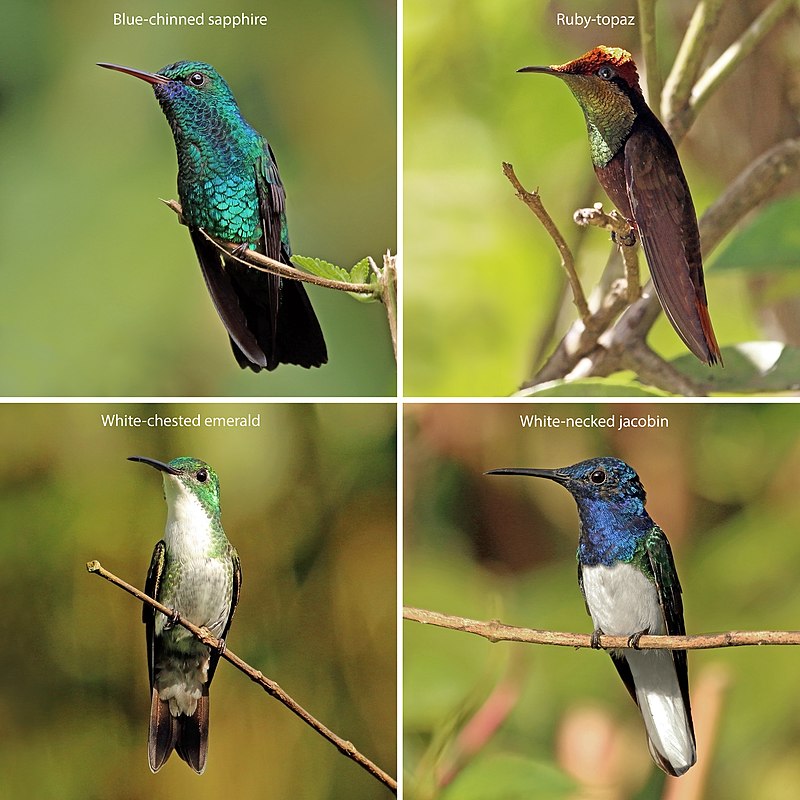
Hummingbirds are tiny birds throughout the Americas, from Alaska to Tierra del Fuego. Most species measure 3-5 inches long and weigh less than an ounce.
The smallest hummingbird is only 2 inches long. Hummingbirds have a unique ability to hover by rapidly flapping their wings up to 80 times per second.
They feed on nectar and insects, with some species even able to drink sap or eat pollen directly off flowers.
Their vibrant colors make them instantly recognizable as they dart through gardens searching for food and mates.
Hummingbirds genuinely bring joy into our lives as they remind us that nature’s beauty can be seen around every corner if we take the time to look for it.
Scientific classification:
| Kingdom | Animalia |
| Phylum | Chordata |
| Class | Aves |
| Order | Apodiformes |
| Family | Trochilidae Vigors, 1825 |
4. Toucans
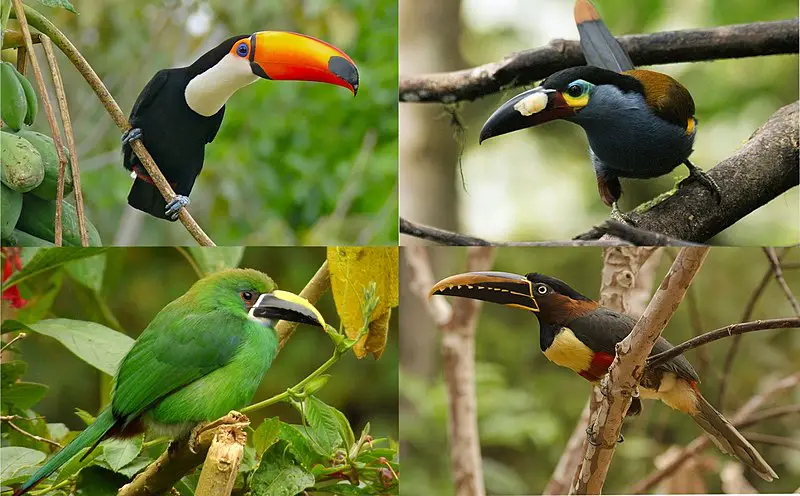
Toucans are members of the Ramphastidae family, closely related to American barbets. These birds have brightly colored feathers and large beaks that come in various colors.
They tend to live high up in trees, making their nests with two or four white eggs inside.
Toucans typically feed on fruits and sometimes small insects as well. Some species can even catch larger animals, such as reptiles and amphibians, for food.
Although toucans like to stay close together when living in groups, they become more aggressive towards each other during breeding season due to competition over resources like nesting sites or food sources.
Scientific classification:
| Kingdom | Animalia |
| Phylum | Chordata |
| Class | Aves |
| Order | Piciformes |
| Infraorder | Ramphastides |
| Family | Ramphastidae Vigors, 1825 |
5. Keel-Billed Toucan
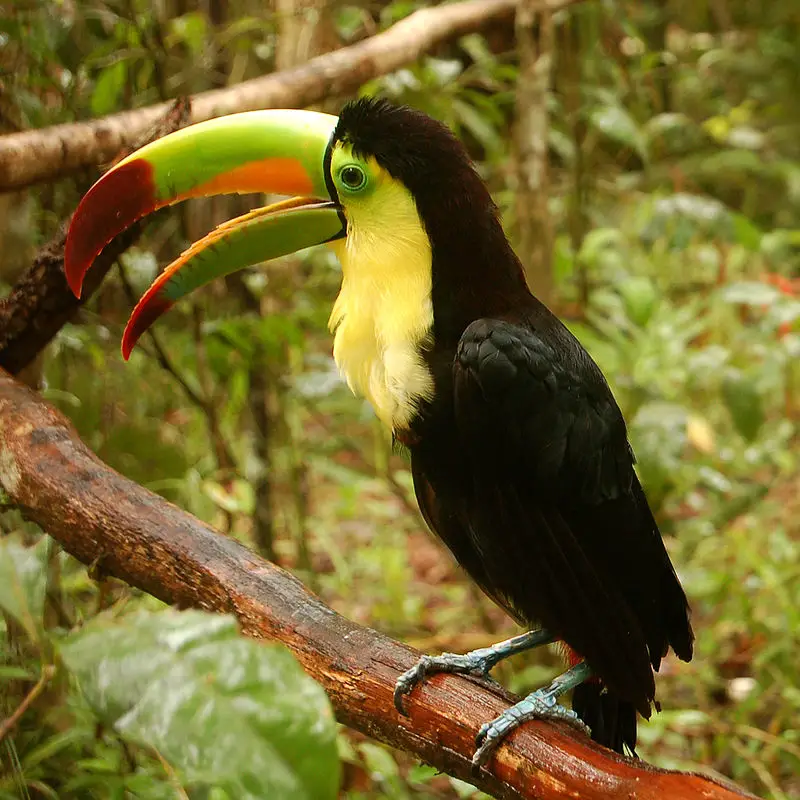
The Keel-billed Toucan is a vibrant Latin American from the toucan family and serves as Belize’s national bird. They are found in tropical jungles stretching from southern Mexico to Colombia.
They feed on fruits, seeds, insects, lizards, and snakes – omnivorous birds eat almost anything.
These colorful creatures have impressive beaks with green upper body parts and yellow lower halves.
The underside of their tail feathers is black, while their tips remain white, creating a stunning display when flying or perched atop tree branches.
Scientific classification:
| Kingdom | Animalia |
| Phylum | Chordata |
| Class | Aves |
| Order | Piciformes |
| Family | Ramphastidae |
| Genus | Ramphastos |
| Species | R. sulfuratus |
6. Tanagers
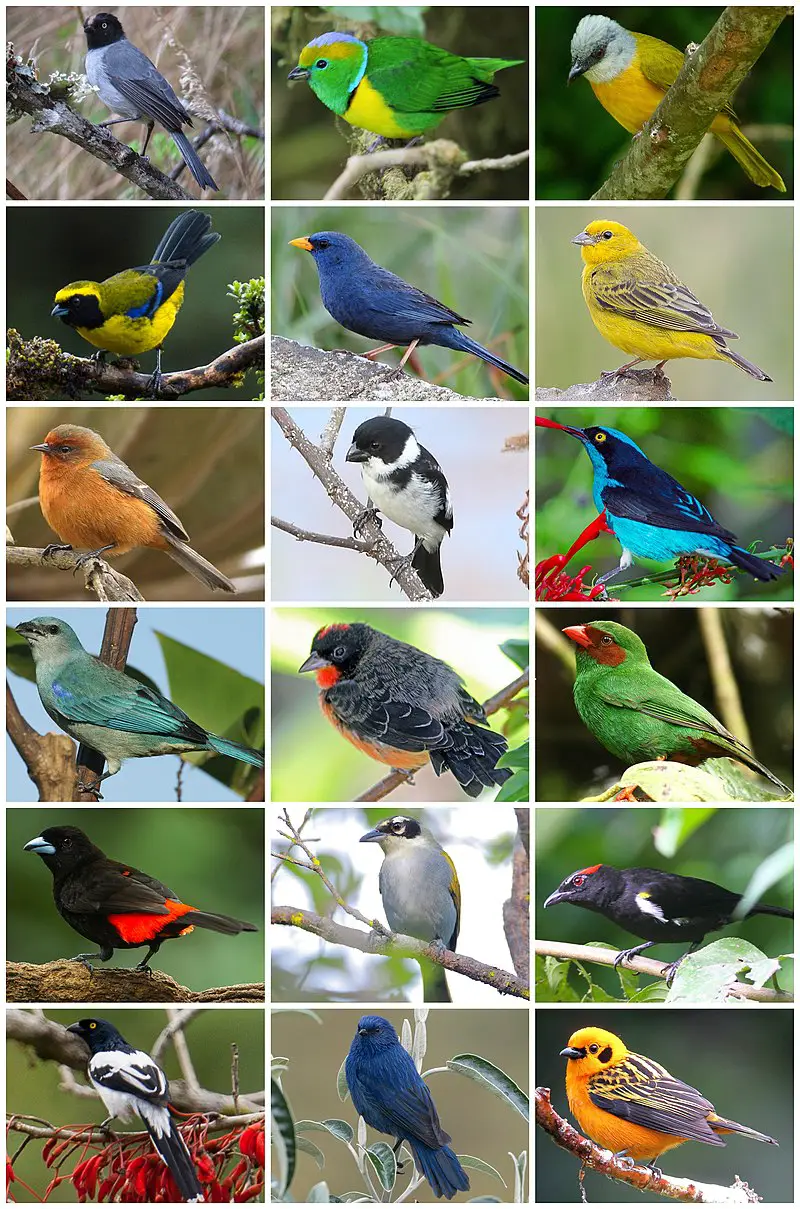
The Tanagers are a beautiful and diverse family of birds native to the Neotropical region. They boast an impressive array of colors, including blues, greens, yellows, and reds.
The most common type is the fruit-eating tanager in tropical forests across Latin America. With nearly 240 species worldwide, they represent almost 4% of all avian species.
These vibrant birds have adapted well to their environment due to their substantial bills for cracking open hard fruits and sharp claws for gripping branches while feeding or perching.
As with many other bird families, there is natural variation among populations, making each one unique in its own way and even more special.
Scientific classification:
| Kingdom | Animalia |
| Phylum | Chordata |
| Class | Aves |
| Order | Passeriformes |
| Superfamily | Emberizoidea |
| Family | Thraupidae Cabanis, 1847 |
7. Trogon
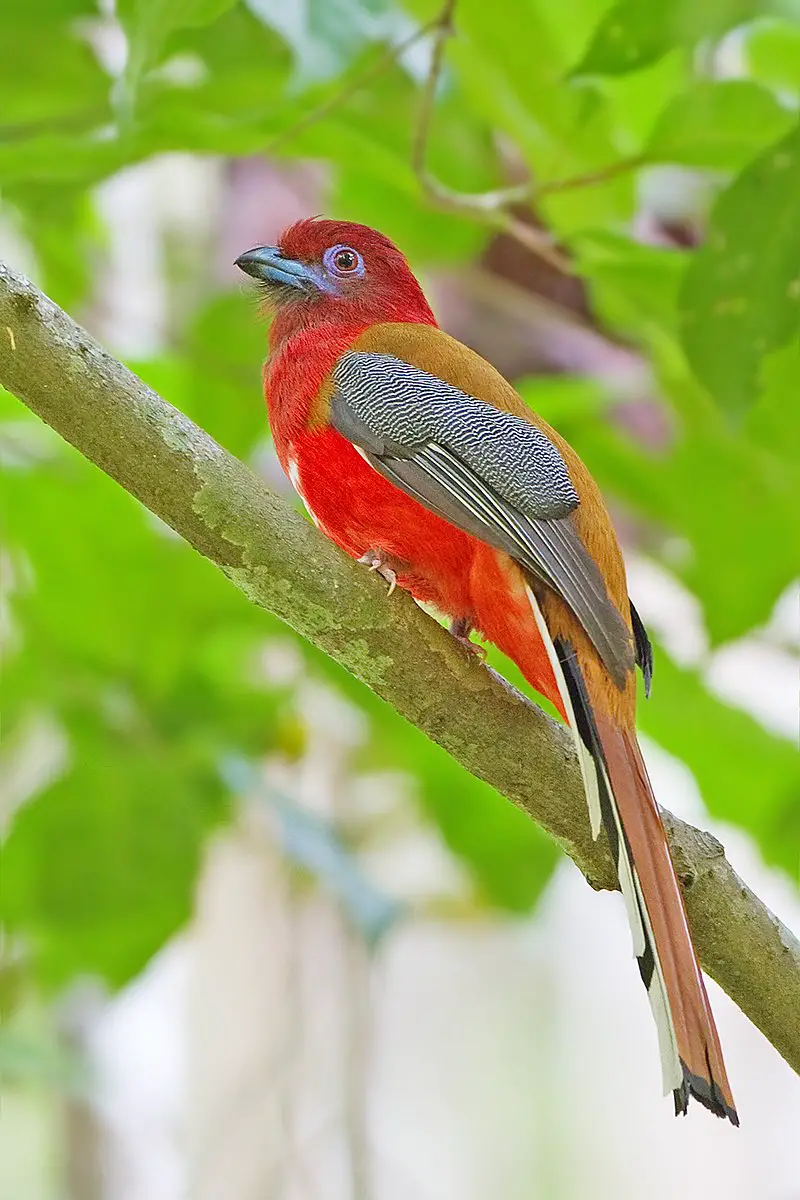
Trogons are a unique bird species that can be found all over the world. They belong to the order Trogoniformes and have only one family, called Trogonidae, which consists of 46 species in seven genera.
Fossil records show that trogons existed 49 million years ago during the Early Eocene period. They may be closely related or form part of two other orders: Coraciiformes and Passerines.
These birds typically have brightly colored feathers, with some having iridescent colors on their wings and tails, as well as red bellies and breasts.
Their diet mainly consists of fruit, insects, lizards, and frogs, but larger ones will also feed on small mammals such as mice or bats.
The most famous member of this group is Quetzalcoatlus – an extinct giant pterosaur that lived approximately 70-65 million years ago.
Scientific classification:
| Kingdom | Animalia |
| Phylum | Chordata |
| Class | Aves |
| Clade | Cavitaves |
| Clade | Eucavitaves |
| Order | Trogoniformes AOU, 1886 |
| Family | Trogonidae Lesson, 1828 |
8. Clay-Colored Thrush

The Clay-colored Thrush is a common Middle American bird belonging to the Thrush family. It has become Costa Rica’s national bird, using the name yigüirro in Spanish.
It inhabits South Texas and parts of northern Colombia, and its range extends westward and northward from Isthmus Tehuantepec.
It has an overall buffy coloration with brownish upperparts, which help distinguish this species from other birds within its habitat.
Additionally, some individuals have white tips on their tail feathers that differentiate them from others.
This hardy species continues to thrive in many different habitats across Central America, making it one of the most widespread songbirds.
Scientific classification:
| Kingdom | Animalia |
| Phylum | Chordata |
| Class | Aves |
| Order | Passeriformes |
| Family | Turdidae |
| Genus | Turdus |
| Species | T. gray |
Also Featured In: Birds You’ll Find in South Texas, Common Latin America Birds
9. Motmot
Motmots are a family of birds in Coraciiformes, known for their vibrant plumage and relatively heavy bills. They inhabit woodlands or forests across the Neotropics and can range in size from small to large.
The most distinctive feature of motmot species is their long tail feathers. Some are adorned with unique patterns like eyespots.
Their diet consists mainly of insects, but will also eat smaller vertebrates such as lizards, frogs, and fish.
Motmots are active during daylight hours, perching on branches along forest edges or flitting through trees hunting prey.
These beautiful creatures have become essential to many people’s lives throughout Latin America because local cultures consider them good luck symbols.
Scientific classification:
| Kingdom | Animalia |
| Phylum | Chordata |
| Class | Aves |
| Order | Coraciiformes |
| Family | Momotidae GR Gray, 1840 |
10. Fiery-Billed Aracari
The Fiery-billed Aracari is a beautiful bird native to Costa Rica and Panama. It belongs to the Toucan family Ramphastidae, closely related to the Collared Aracari.
This species of aracari has vibrant plumage with its namesake fiery bill and yellow markings on both sides of its neck that resemble a collar.
Its body is mainly black but adorned with bright yellow patches beneath each wing and white streaks across its wings, tail feathers, and backside.
The Fiery-billed Aracar’s diet consists mainly of fruits, though they feed on insects for protein when necessary.
Their singing can be heard in wooded areas throughout their range in Central America during dawn or dusk hours.
Scientific classification:
| Kingdom | Animalia |
| Phylum | Chordata |
| Class | Aves |
| Order | Piciformes |
| Family | Ramphastidae |
| Genus | Pteroglossus |
| Species | P. Frantz |
11. White-Throated Magpie-Jay
The White-throated Magpie-Jay is a large, gregarious bird native to Central America. It has an unmistakable white throat, black head, striking blue wings, and tail feathers.
Its range extends from Jalisco, Mexico, to Guanacaste in Costa Rica, where it inhabits Pacific-slope thorn forest habitats.
English naturalist William John Swainson formally described this magpie species in 1827. Since then, they have become known for their noisy behavior, often including mobbing intruders into their territory.
They travel in flocks, making them easy to spot but challenging for those who wish to avoid attention.
Scientific classification:
| Kingdom | Animalia |
| Phylum | Chordata |
| Class | Aves |
| Order | Passeriformes |
| Family | Corvidae |
| Genus | Calocitta |
| Species | C. Formosa |
12. Tyrant Flycatchers
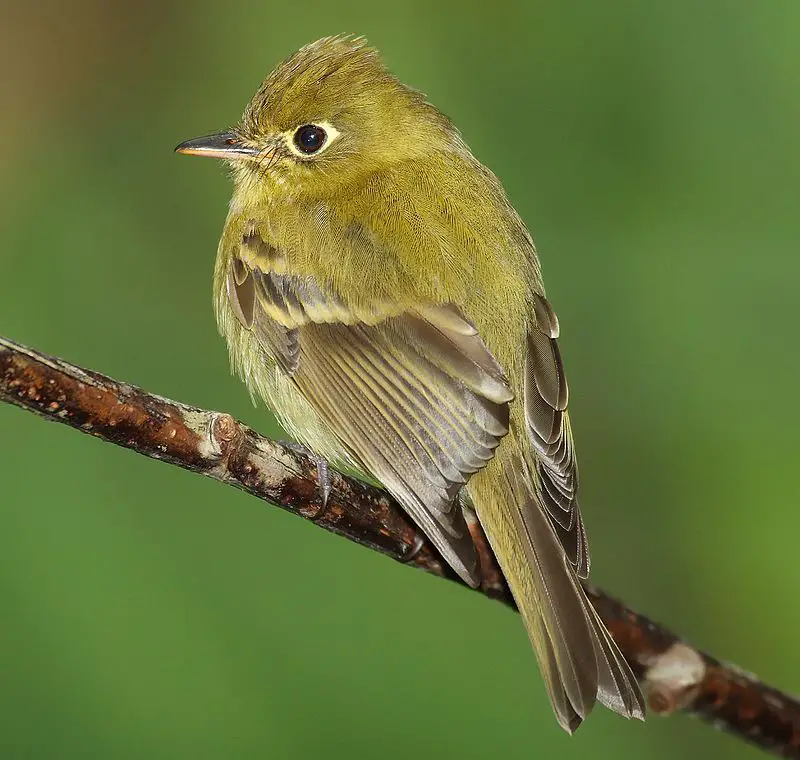
Tyrant flycatchers are a family of birds found in North and South America, containing over 400 species. These birds come in various shapes and sizes, with vibrant plumage to match.
They are the most diverse avian family in all countries except for the United States and Canada.
Their diet consists mainly of insects and includes small reptiles or amphibians where available.
The behavior varies between birds; some prefer open areas, while others like dense forests as their habitat �. Many even migrate regularly.
Tyrant Flycatchers have adapted well to human presence thanks to the abundance of food sources that often accompany them �, such as backyards, parks, etc.
These incredible creatures are genuinely unique.
Scientific classification:
| Kingdom | Animalia |
| Phylum | Chordata |
| Class | Aves |
| Order | Passeriformes |
| Parvorder | Tyrannida |
| Family | Tyrannidae Vigors, 1825 |
13. Great Green Macaw
The great green macaw is a beautiful Central and South American parrot that can be found from Honduras to Colombia as well as Nicaragua, Costa Rica, Panama, and Ecuador.
Its bright red forehead, yellow cheeks, and blue wings make it easy to spot in the wild.
This magnificent bird has two recognized subspecies: Ara ambiguus ssp. ambiguus, which ranges across most of its range, while Ara ambiguus ssp. guayaquilensis appears exclusive to northwestern Ecuador.
These birds are usually seen foraging for seeds, but their diet also includes fruits such as figs or palm nuts, making them an essential part of tropical ecosystems.
Scientific classification:
| Kingdom | Animalia |
| Phylum | Chordata |
| Class | Aves |
| Order | Psittaciformes |
| Family | Psittacidae |
| Genus | Ara |
| Species | A. ambiguous |
14. King Vulture
The King Vulture is a majestic bird found in Central and South America. It has striking white plumage with black accents, and a bright yellow crest tops its head.
With an extended wingspan of up to 4 feet, this vulture soars gracefully through the sky. Its large size allows it to dominate other scavenging birds at carcasses; although not as powerful as some raptors, the king vulture will fiercely protect what belongs to it.
The diet of these elegant creatures consists mainly of carrion, such as dead mammals or fish that they spot from far away using their excellent vision.
They also occasionally eat eggs or nestlings if food is scarce during dry seasons.
This fascinating species plays a vital role in keeping ecosystems healthy by quickly removing dead animals from landscapes before diseases spread further into populations.
Scientific classification:
| Kingdom | Animalia |
| Phylum | Chordata |
| Class | Aves |
| Order | Accipitriformes |
| Family | Cathartidae |
| Genus | Sarcoramphus |
| Species | S. papa |
15. Wrens
Wrens are a family of small brown passerine birds found mainly in the Americas. They are considered one of the most abundant bird species, with 88 known varieties divided into 19 genera.
The Eurasian wren is the only type inhabiting Europe and other parts of the Old World, commonly referred to simply as “wren.”
This species has been given its name due to similar-looking unrelated birds living elsewhere, such as New Zealand wrasses.
Wrens have tiny bodies with thin bills and long tails, which they often hold upright for hours while singing their loud, cheery songs from treetops or low shrubs.
Their diet consists mainly of insects but can also include fruits and seeds depending on availability in their habitat range.
Scientific classification:
| Kingdom | Animalia |
| Phylum | Chordata |
| Class | Aves |
| Order | Passeriformes |
| Superfamily | Certhioidea |
| Family | Troglodytidae Swainson, 1832 |
16. Amazonian Motmot
The Amazonian Motmot is a vibrant bird belonging to the family Momotidae. It can be found in lowland areas of South America, from Venezuela to Brazil and Argentina.
This colorful near-passerine has an impressive body length of up to 18 cm (7 inches) with striking green and blue plumage.
Its characteristic long tail tipped with two central feathers gives it a unique appearance that sets it apart from other birds in its region.
The diet consists mainly of insects, small reptiles, amphibians, and fruits and berries when available nearby.
As monogamous birds, males use their bright colors for display during courtship rituals, which involve bowing displays and aerial acrobatics while chasing each other around tree branches.
Scientific classification:
| Kingdom | Animalia |
| Phylum | Chordata |
| Class | Aves |
| Order | Coraciiformes |
| Family | Momotidae |
| Genus | Momotus |
| Species | M. momota |
17. Thrush
Thrushes are small to medium-sized birds belonging to the Turdidae family and found all over the world. They live on or near the ground and feed on insects, other invertebrates, and fruit.
Their feathers range from greyish browns to deep blues with ted wings that help them blend into their natural habitats, such as forests, woodlands, and shrubs.
Thrushes sing distinctive songs during spring mating season; many species also perform complex flight displays for courtship rituals.
These birds may be solitary creatures but can often be seen foraging together in groups or pairs when searching for food sources like worms, snails, or berries.
A healthy thrush population indicates a balanced environment since they require clean water sources and plenty of vegetation cover – making them critical indicators of ecosystem health worldwide.
Scientific classification:
| Kingdom | Animalia |
| Phylum | Chordata |
| Class | Aves |
| Order | Passeriformes |
| Suborder | Passeri |
| Family | Turdidae Rafinesque, 1815 |
18. Turquoise-Browed Motmot
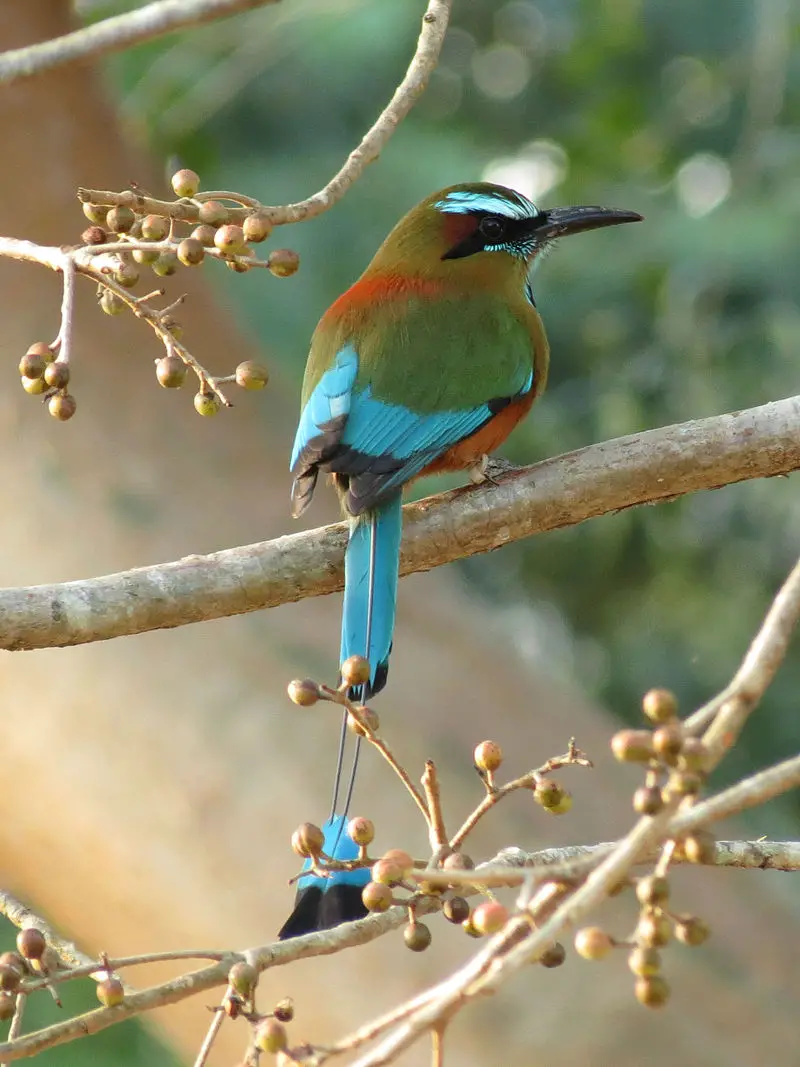
The turquoise-browed motmot is a beautiful bird of the Momotidae family. It can be found in Central America, from southeast Mexico to Costa Rica, where it is common and not considered threatened.
This species enjoys living in open habitats such as forest edges, gallery forests, or scrubland.
They are more visible than other Motmots due to their large size and bright coloration, including an iridescent blue back and yellowish chest with black spots on their throat feathers.
Turquoise-browed motmots have unique features that set them apart; they have two long tail feathers that dangle behind them while flying like streamers, earning themselves the nickname “the flying orchestra.”
In addition, they are known for their loud calls during mating season, which makes them easily recognizable.
Scientific classification:
| Kingdom | Animalia |
| Phylum | Chordata |
| Class | Aves |
| Order | Coraciiformes |
| Family | Momotidae |
| Genus | Eumomota P.L. Sclater, 1858 |
| Species | E. superciliosa |
19. Mangrove Hummingbird
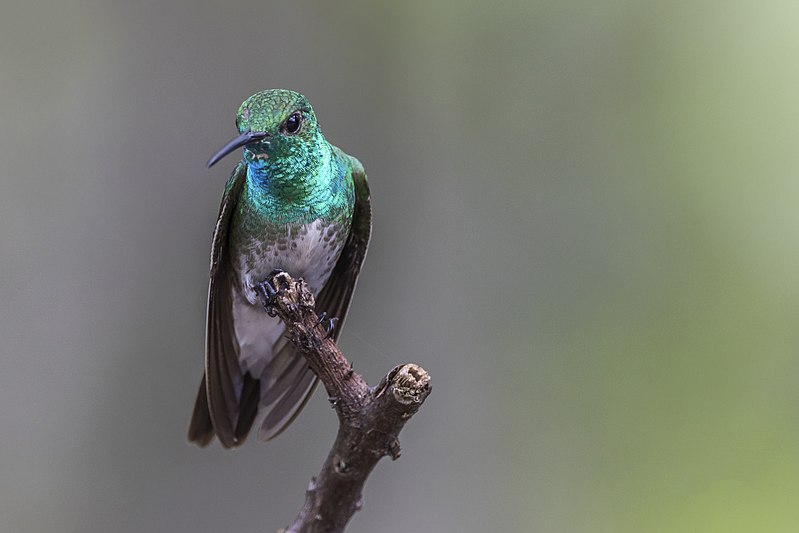
The Mangrove Hummingbird is an endangered species of hummingbird that is endemic to Costa Rica.
It was first described in 1877 by French ornithologist Étienne Mulsant from a specimen collected near Puntarenas by Adolphe Boucard.
This bird belongs to the Trochilini tribe and subfamily Trochilinae, commonly called “emeralds.”
Its plumage consists mainly of green with some black on its head and throat, while its tail feathers are reddish-brown at their base.
The Mangrove Hummingbird feeds primarily on nectar but eats small insects for protein – such as ants and spiders – which it catches in midair using its long bill and tongue.
Since it lives close to mangroves, this species plays a vital role in pollinating these trees’ flowers, which helps keep them healthy.
Unfortunately, due to deforestation, they have been pushed out of much of their natural habitat, making conservation efforts even more critical if we want future generations to enjoy seeing this beautiful little bird.
Scientific classification:
| Kingdom | Animalia |
| Phylum | Chordata |
| Class | Aves |
| Order | Apodiformes |
| Family | Trochilidae |
| Genus | Amazilia |
| Species | A. Bacardi |
20. Blue-Gray Tanager
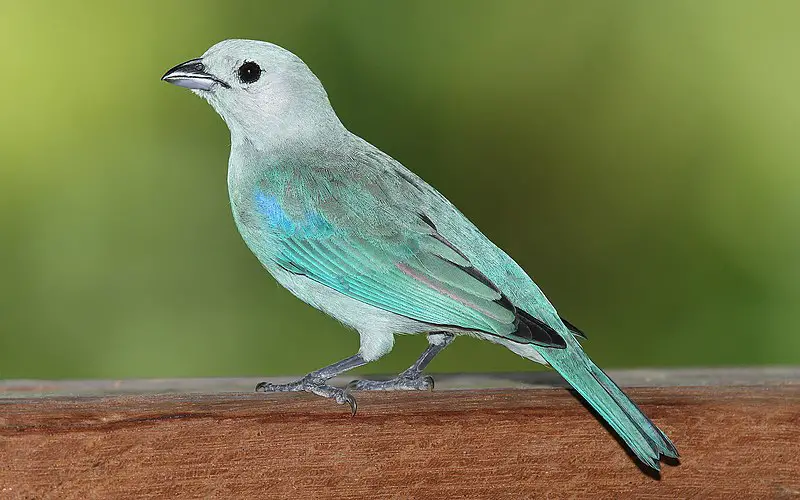
The blue-gray tanager is a medium-sized songbird native to South America, from Mexico to northern Brazil and Bolivia.
It has been introduced in Lima, Peru, and Trinidad and Tobago, where it is called “blue jeans.”
This species was first described by French zoologist Mathurin Jacques Brisson in 1760. The bird’s plumage features gray, blue, yellow, and green hues, creating an attractive contrast against its white belly.
Its diet consists mainly of insects like beetles, and fruits such as figs are known to be part of their daily nutrition.
Blue-gray tanagers usually inhabit humid forests near running watercourses, making them relatively easy to spot. At the same time, they search for food on tree branches or foliage cover around streams during the day.
Scientific classification:
| Kingdom | Animalia |
| Phylum | Chordata |
| Class | Aves |
| Order | Passeriformes |
| Family | Thraupidae |
| Genus | Thraupis |
| Species | T. episcopus |
21. Violet Sabrewing
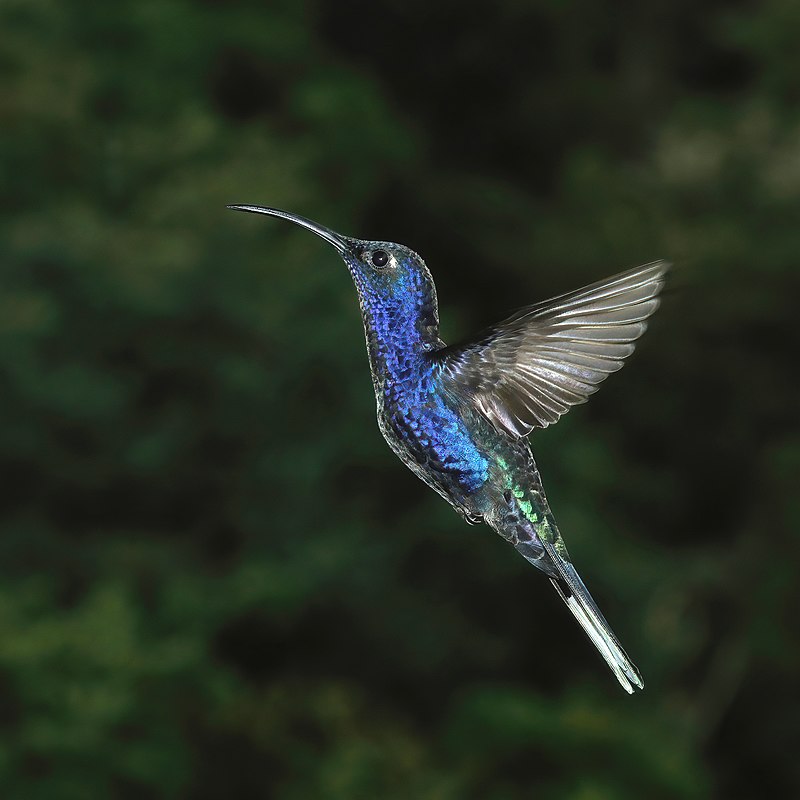
The Violet Sabrewing is the most giant hummingbird in Mexico and Central America, with a length of 13-15cm (5.1 to 5.9in).
It belongs to the Trochilini tribe of Emeralds subfamily (Trochilinae) and has two distinct species – C. h. Hemileucurus and C. h.. mellitus were found from Mexico to Panama.
This colorful bird typically sports an iridescent violet throat, shining green back, white breast, black head, tail feathers, and beak tip, all adding to its stunning beauty.
Its diet consists mainly of nectar, which it collects from flowers by hovering around them as typical hummingbirds, but it also feeds on small insects for much-needed protein intake.
The Violet Sabrewing is known for its long migrations across great distances to find suitable places where food sources are abundant during different seasons.
Scientific classification:
| Kingdom | Animalia |
| Phylum | Chordata |
| Class | Aves |
| Order | Apodiformes |
| Family | Trochilidae |
| Genus | Campylopterus |
| Species | C. hemileucurus |
22. Golden-Hooded Tanager
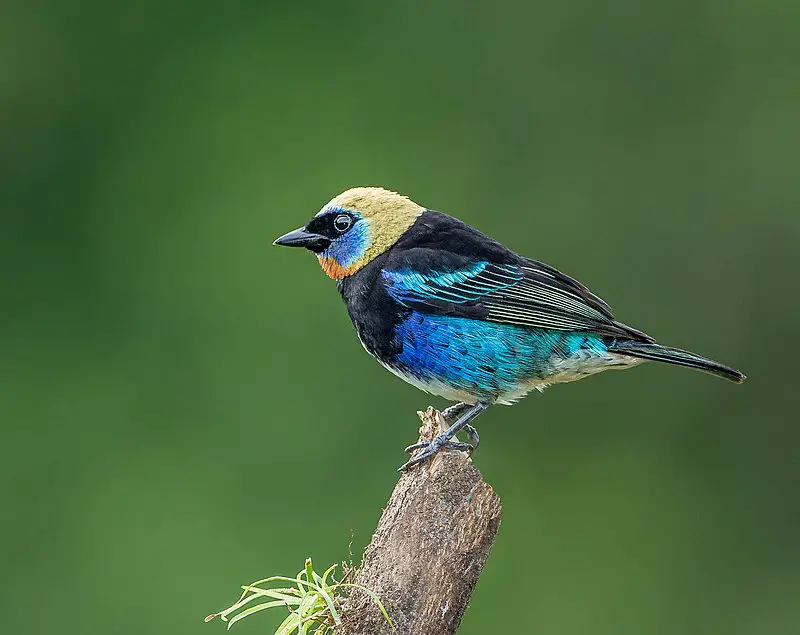
The Golden-hooded Tanager is a medium-sized passerine bird in Central and South America. It has an impressive appearance with its golden head, black eye mask edged with violet-blue above and below and turquoise shoulders.
These birds measure 13 cm long and weigh 19 g on average.
They are known to be resident breeders from Mexico down to western Ecuador, where they can often be seen gathering around fruiting trees or shrubs, searching for food such as berries and small insects.
The males often aggressively defend their territories against other intruders during the breeding season, which usually occurs between April and August, when the female will lay 2-3 white eggs in a cup nest built high up near tree branches by both parents.
Scientific classification:
| Kingdom | Animalia |
| Phylum | Chordata |
| Class | Aves |
| Order | Passeriformes |
| Family | Thraupidae |
| Genus | Stilpnia |
| Species | S. larvata |
23. Great Kiskadee
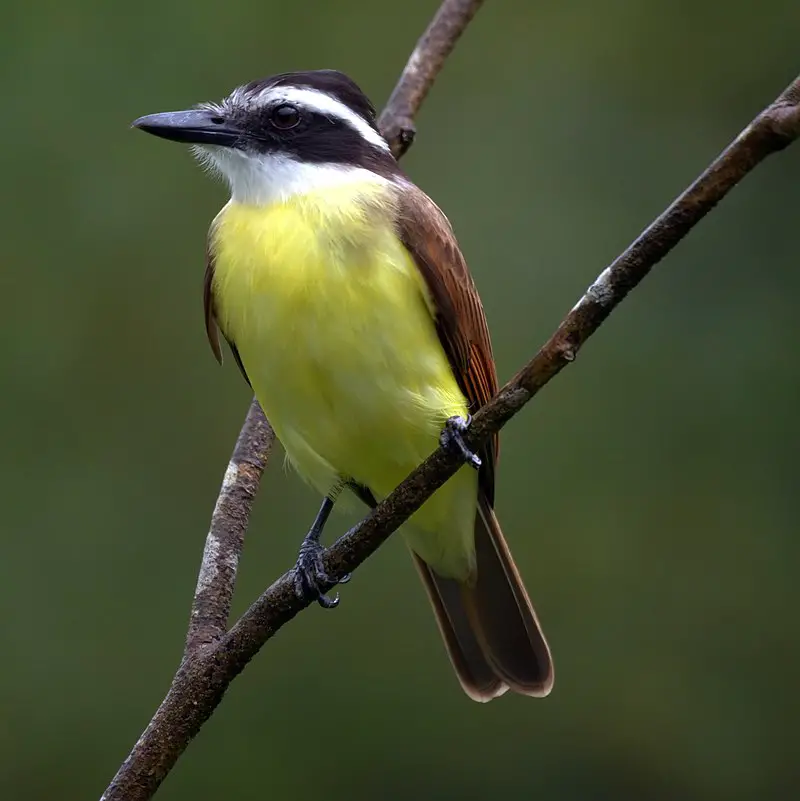
The Great Kiskadee is a passerine bird belonging to the Tyrant Flycatcher family.
It has an unmistakable yellow and black plumage, making it easily recognizable in its native habitats of Belize, Texas, Argentina, and Brazil, known as Bem-te-vi or Benteveo, respectively.
The species inhabits open woodland with some tall trees, such as cultivation areas and other places surrounding human dwellings.
This adaptable bird feeds mainly on insects but consumes fruit for energy when needed.
Its call resembles laughter, which adds to its charm among avid nature watchers who are always delighted by their presence.
A unique feature that sets this species apart is that they can imitate songs of other birds accurately, too.
Scientific classification:
| Kingdom | Animalia |
| Phylum | Chordata |
| Class | Aves |
| Order | Passeriformes |
| Family | Tyrannidae |
| Genus | Pitangus Swainson, 1827 |
| Species | P. sulphuratus |
24. Bay-Headed Tanager
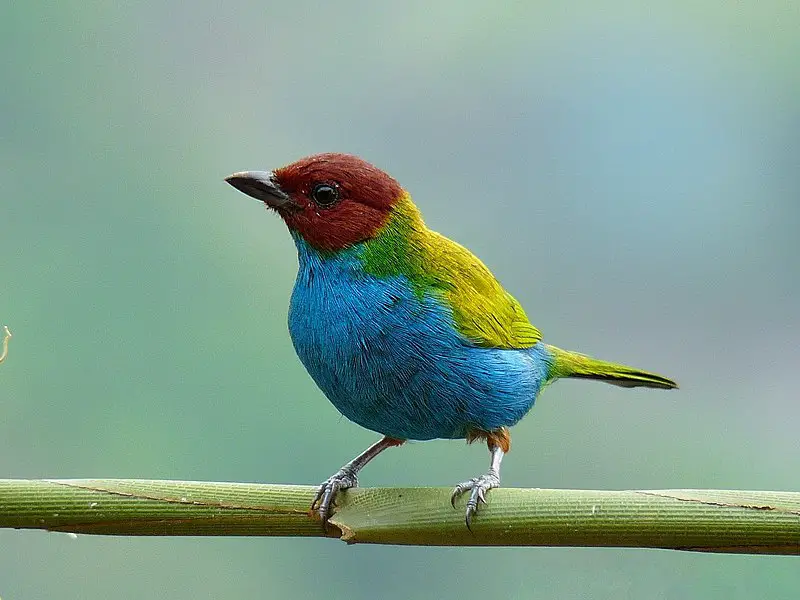
The Bay-headed Tanager is a medium-sized passerine bird in Costa Rica, Panama, South America, and even Trinidad. It was first described by Swedish naturalist Carl Linnaeus back in 1758.
This tanager has an olive green head, black streaks on its wings, pale blue breasts, and dark bluish-grey upperparts.
They feed primarily on fruits but eat insects such as flies and caterpillars when available.
The male bay-headed tanagers are more brightly colored than females; they have yellowish heads, while the females have duller or brownish coloring.
These birds usually live alone or form small flocks during winter to migrate southward for breeding season around April to September, depending upon location.
Scientific classification:
| Kingdom | Animalia |
| Phylum | Chordata |
| Class | Aves |
| Order | Passeriformes |
| Family | Thraupidae |
| Genus | Tangara |
| Species | T. gyro-la |
25. Crested Caracara
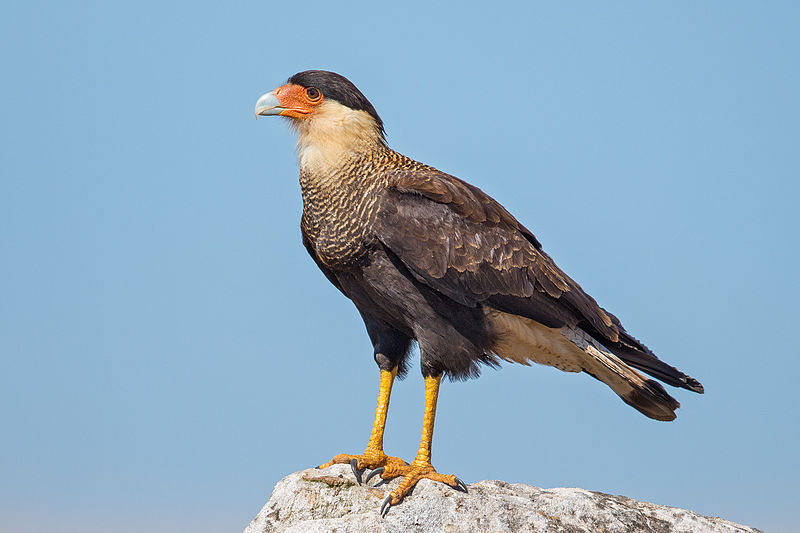
The Crested Caracara is a majestic bird of prey found from the Southern United States through Central and South America, down to Tierra del Fuego.
It has an impressive wingspan ranging from 120-132 cm, with adults averaging 1,348 g in weight. This species is known for its characteristic crest on top of its head that can be raised when they are alarmed or excited.
They have pale yellow legs and feet and dark brown feathers covering most of their body.
The Crested Caracara feeds mainly on carrion but will also take live food, such as small mammals, reptiles, birds, and garbage if available near them.
These fantastic raptors form strong family bonds between siblings, often lasting until adulthood, making them one of nature’s most remarkable creatures.
Scientific classification:
| Kingdom | Animalia |
| Phylum | Chordata |
| Class | Aves |
| Order | Falconiformes |
| Family | Falconidae |
| Genus | Caracara |
| Species | C. plans |
26. Antbird
Antbirds are a group of passerine birds found in Central and South America. They range from 10–30 cm long and weigh between 14-50 gm. Antbirds have short, rounded wings, but their legs are vital for running on the ground or jumping through vegetation when chasing after prey.
The plumage of most antbird species is generally blackish or grey with some shades of browns, whites, and yellows; however, there is substantial variation among different species.
Antbirds feed mainly on insects such as ants, termites & beetles, which they find by following swarms of army ants across the forest floor in search of food items disturbed by these marauding columns.
In addition to insects, they eat fruits and small lizards & frogs occasionally while hunting near water sources like streams and rivers that flow through tropical rainforest habitats where many antbird species occur naturally.
27. Three-Wattled Bellbird
The Three-wattled bellbird is an impressive migratory bird of Central America belonging to the Cotinga family.
It has a unique look, with males having white heads and throats, chestnut brown plumage, and three long black wattles dangling from the base of their beaks.
Females, on the other hand, have olive plumage with yellowish streaked underparts and lack wattles altogether.
They are very vocal birds producing loud ringing calls which can be heard up to 1 kilometer away in ideal environmental conditions.
Their diet consists mainly of fruits, insects, lizards, or frogs that they catch while flying low over vegetation such as trees or forests during migration season.
The Three-wattled bellbird stands out among its peers due to its beautiful coloration and vocalizations, making it one of many interesting species in Central American habitats today.
Scientific classification:
| Kingdom | Animalia |
| Phylum | Chordata |
| Class | Aves |
| Order | Passeriformes |
| Family | Cotingidae |
| Genus | Procnias |
| Species | P. tricarunculatus |
28. Long-Tailed Manakin
The Long-tailed Manakin is a small bird native to Central America. It inhabits wet and dry tropical and subtropical forests, usually measuring just 10 centimeters (4 inches) long.
The male has striking black plumage, vivid blue back feathers, and a red crown.
Its most remarkable feature, however, is the two central tail feathers, which have been considerably elongated over time – giving it an unmistakable silhouette in flight.
Females and juveniles display olive green coloring instead of the males’ more vibrant palette, creating an exciting contrast amongst family groups within these lush habitats.
Scientific classification:
| Kingdom | Animalia |
| Phylum | Chordata |
| Class | Aves |
| Order | Passeriformes |
| Family | Pipridae |
| Genus | Chiroxiphia |
| Species | C. linearis |
29. Cotinga
Cotingas are a large family of passerine birds that inhabit Central and South America. They have broad bills, hooked tips, rounded wings, and strong legs.
These colorful birds usually live in forests or forest edges and feed mainly on fruits. Cotinga species range from 12-13 cm (4.7–5.1 inches) to 48-51 cm long, depending on the type of bird.
The fiery-throated fruiteater is among the smallest members, while others, like cocks -of –rock, can reach up to 51cm long.
All these birds display spectacular colors, which makes them popular amongst bird watchers all over the world.
Scientific classification:
| Kingdom | Animalia |
| Phylum | Chordata |
| Class | Aves |
| Order | Passeriformes |
| Parvorder | Tyrannida |
| Family | Cotingidae Bonaparte, 1849 |
Also Featured In: Birds That Live in the Jungle, Rainforest Birds You Should Know
30. Baird’s Trogon
Baird’s trogon is a beautiful species of bird belonging to the family Trogonidae. It can be found in Costa Rica and Panama, and its name pays tribute to Spencer Fullerton Baird – a 19th-century naturalist and first curator of the Smithsonian Institution.
This colorful bird has olive-green upperparts, bright yellow underparts, and red undertail coverts.
Its eye is an orange eyering that gives it a striking appearance amongst other birds in its range. The diet mainly consists of fruits supplemented by insects such as beetles or bees.
They use their long tail for balance while perched atop branches high up trees where they build nests made of twigs lined with grasses. To distinguish males and females, look for black throat spots present only in males.
Scientific classification:
| Kingdom | Animalia |
| Phylum | Chordata |
| Class | Aves |
| Order | Trogoniformes |
| Family | Trogonidae |
| Genus | Trogon |
| Species | T. bairdii |
31. Icterids
Icterids are a family of small to medium-sized, often colorful New World passerine birds. They have black as their predominant plumage color, with yellow, orange, or red adding vibrancy and life.
Their sizes range significantly in shape and behavior, making them unique amongst other bird species.
The name Icterid comes from the Latin word ‘icterus,’ which means jaundiced ones – referring to the prominent yellow coloring on some of these birds’ feathers.
These beautiful creatures fly around many parts of South America, where they live with their young for most of the year before migrating northwards during the fall season.
Scientific classification:
| Kingdom | Animalia |
| Phylum | Chordata |
| Class | Aves |
| Order | Passeriformes |
| Superfamily | Emberizoidea |
| Family | Icteridae Vigors, 1825 |
32. Acorn Woodpecker
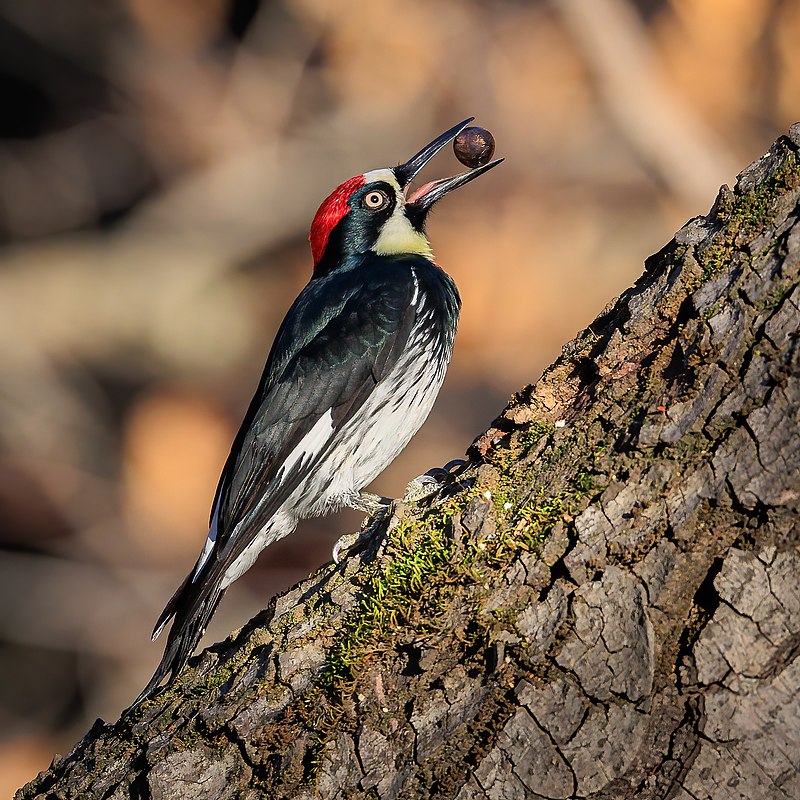
The Acorn woodpecker is a medium-sized bird with an average weight of 85 grams and 8.3 inches in length. It was first described by the English naturalist William John Swainson from a specimen collected in Mexico in 1827.
Its scientific name, Melanerpes formicivorus, combines the Latin words “ant” and “-vorous.”
This species has distinct black plumage all over its body except for some white patches on its wings and tail feathers, which can be seen when flying or perched atop trees.
They are known to store acorns inside tree crevices and within bark cracks – often using them during lean times.
The acorn woodpecker is also socially active; they live with other birds of their kind in groups called ‘granaries.’ Their chirps are loud enough that they can easily be heard from afar.
Scientific classification:
| Kingdom | Animalia |
| Phylum | Chordata |
| Class | Aves |
| Order | Piciformes |
| Family | Picidae |
| Genus | Melanerpes |
| Species | M. formicivorus |
33. Black-Crested Coquette
The Black-crested Coquette is a hummingbird species inhabiting Belize, Costa Rica, Guatemala, Honduras, Mexico, and Nicaragua. It has a striking black crest atop its small body, making it easy to spot in the wild.
Its short but powerful wings allow it to hover over flowers with its long bill while feeding on nectar.
The male also performs elaborate courtship displays to attract female mates during breeding by spreading an iridescent throat patch and doing aerial dives high above trees or shrubs.
This bird typically nests near low vegetation such as bamboo thickets due to their preference for staying close to the ground so they can quickly take off if disturbed or threatened by predators or humans nearby.
Scientific classification:
| Kingdom | Animalia |
| Phylum | Chordata |
| Class | Aves |
| Order | Apodiformes |
| Family | Trochilidae |
| Genus | Lophornis |
| Species | L. Helena |
34. Yellow-Billed Cotinga
The yellow-billed cotinga is a rare species of bird found in the Pacific lowlands of Costa Rica and Panama.
This beautiful creature has a bright yellow beak, which gives it its name, and greyish feathers with hints of blue on its wings and tail.
The cotinga’s natural habitats include subtropical or tropical moist forests, mangroves, and shrublands; however, they are under threat due to habitat destruction.
Adults grow up to 18 cm long, making them one of the smallest members among their family Cotingidae.
They mainly feed on fruit but consume small insects such as beetles for protein intake.
Yellow-billed cotingas usually live alone or form pairs during breeding season, where both parents help build nests from twigs and leaves high above ground level in trees or tall bushes.
Scientific classification:
| Kingdom | Animalia |
| Phylum | Chordata |
| Class | Aves |
| Order | Passeriformes |
| Family | Cotingidae |
| Genus | Carpodectes |
| Species | C. Antonia |
35. Collared White start
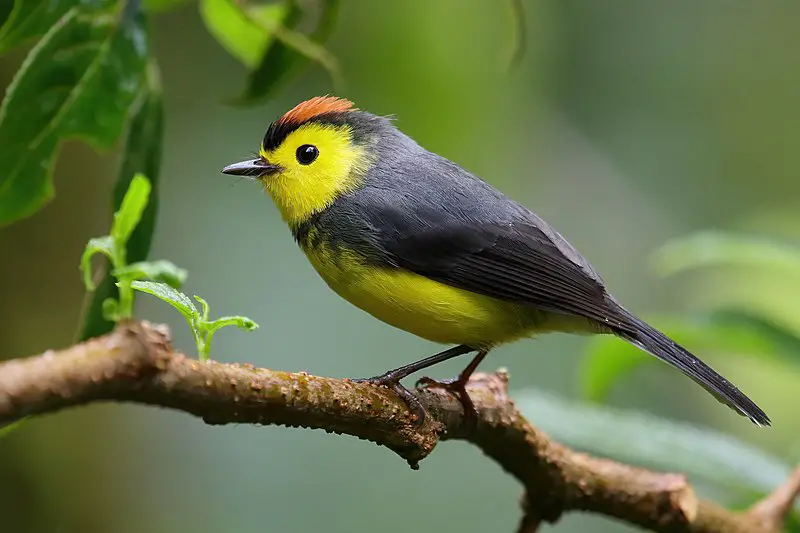
The Collared Whitestart is a small tropical New World warbler found in the mountains of Costa Rica and western-central Panama. It measures approximately 13 cm (5 inches) long, weighing 10.5 grams (0.4 oz).
Its distinguishing features include a chestnut crown bordered by black and a black forehead. The back of its head has slaty gray tones while its underparts are yellowish white across its chest and throat area, varying shades down to grey on its belly area.
Additionally, it sports an eye patch that stands out due to the contrast between dark colors around it, along with two narrow buff stripes running from the neck up towards the sides of the head alongside several thin streaks going over the wings as well as tail feathers being light brown at the base fading into darker hues near tips end.
Its diet consists mainly of insects such as beetles, caterpillars, ants, and some fruit seeds, making this bird a beautiful sight for anyone lucky enough to spot it in their natural habitat.
Scientific classification:
| Kingdom | Animalia |
| Phylum | Chordata |
| Class | Aves |
| Order | Passeriformes |
| Family | Parulidae |
| Genus | Myioborus |
| Species | M. torquatus |
36. Social Flycatcher
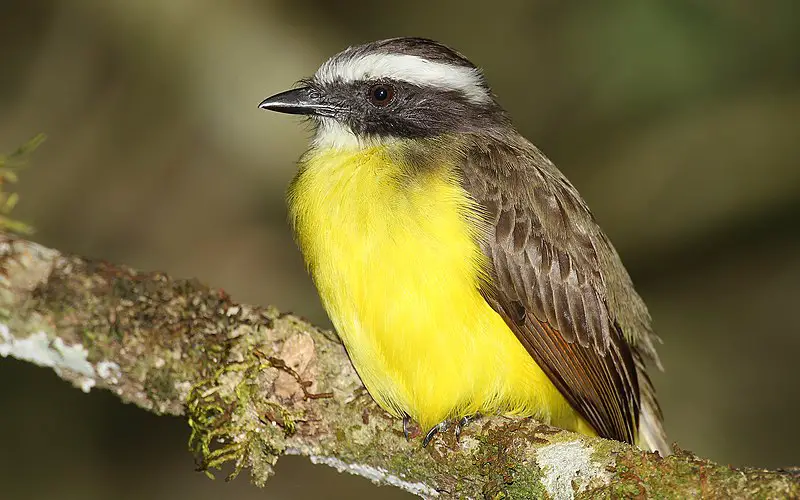
The Social Flycatcher is a medium-sized passerine bird from the Americas, belonging to the large tyrant flycatcher family.
It has often been split into two species – Myiozetetes texensis and Myiozetetes similis proper – due to its distinct range across Costa Rica northwards to Mexico and southward towards South America, respectively.
This bird sports dark grey upperparts, white underparts, and a scarlet crown on its head.
It also possesses an upright posture when perched, making it easily recognizable compared to other birds of similar size within its habitat.
The social flycatcher feeds mainly on insects but can sometimes supplement these meals by eating fruits.
Scientific classification:
| Kingdom | Animalia |
| Phylum | Chordata |
| Class | Aves |
| Order | Passeriformes |
| Family | Tyrannidae |
| Genus | Myiozetetes |
| Species | M. similis |
Also Featured In: Birds that You’ll Find in Chiapas, Birds that Live in Jalisco Birds
37. New World Warblers
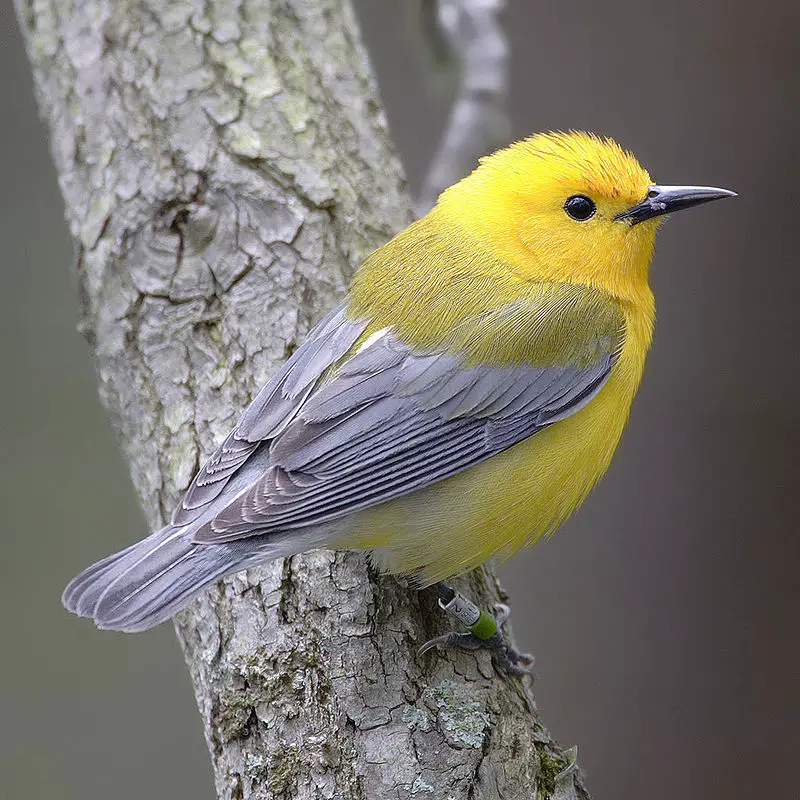
New World warblers are an incredibly diverse family of small birds found only in the Americas. They range in size from tiny hummingbirds to large thrushes and come in various vibrant colors.
All have thin bills made for eating insects, which form their primary diet. Most species live predominantly arboreal lives, meaning they spend most of their time among trees or bushes searching for food.
However, some members, such as ovenbirds and waterthrushes, prefer more terrestrial habitats like forest floors where they can scavenge for bugs on the ground instead.
Warblers provide a great source of entertainment with their beautiful songs, often filling up woodlands during mornings and evenings throughout springtime.
Scientific classification:
| Kingdom | Animalia |
| Phylum | Chordata |
| Class | Aves |
| Order | Passeriformes |
| Superfamily | Emberizoidea |
| Family | Parulidae Wetmore et al., 1947 |
38. Black-Cheeked Woodpecker
The Black-cheeked Woodpecker is a medium-sized, colorful bird found in tropical regions of Mexico, Central America, and Ecuador.
The species has black upperparts with patches of yellow and red on the wings as well as white underparts contrasted by its namesake black cheeks.
These birds are often seen foraging alone or in pairs through their preferred habitats: wet forests, semi-open woodlands, and old secondary growths.
They nest high up in dead trees, laying two to four glossy white eggs that both sexes incubate until hatching.
This species bears the Latin name Melanerpes pucherani, commemorating an Italian naturalist who described it over 200 years ago—a beautiful specimen of nature’s creations.
Scientific classification:
| Kingdom | Animalia |
| Phylum | Chordata |
| Class | Aves |
| Order | Piciformes |
| Family | Picidae |
| Genus | Melanerpes |
| Species | M. pucherani |
39. Roseate Spoonbill
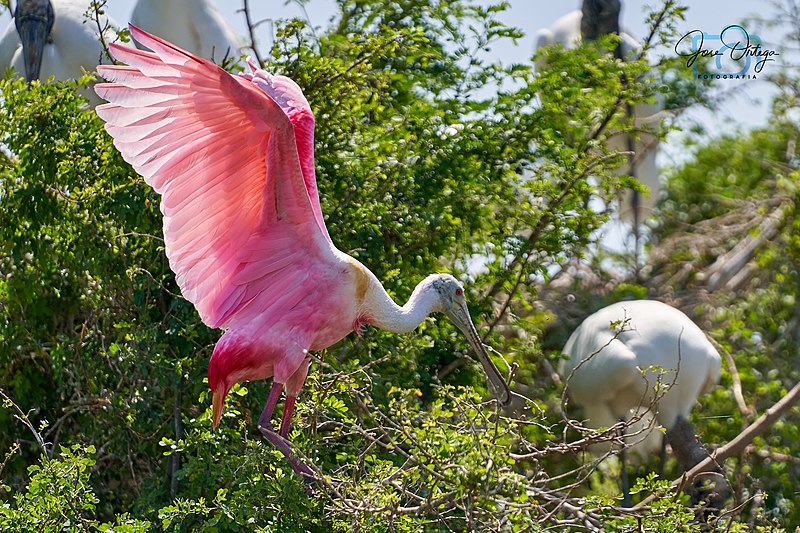
The Roseate Spoonbill is a beautiful and majestic bird in North and South America.
It belongs to the ibis family, Threskiornithidae, and its vibrant pink color comes from canthaxanthin pigment derived from their diet of crustaceans like shrimp.
Sadly, plume hunting almost drove this species close to extinction during the 18th and 19th centuries, but fortunately, it’s coming back due to conservation efforts made by dedicated wildlife organizations.
Its large spoon-like bill helps them filter out food sources such as small fish or frogs from shallow water areas while they wade through mudflats with their long legs looking for something tasty.
With its unique appearance, graceful wingspan, and impressive flight capabilities, the Roseate Spoonbill is an incredibly photogenic animal that will captivate the attention of any viewer lucky enough to witness it in all its glory.
Scientific classification:
| Kingdom | Animalia |
| Phylum | Chordata |
| Class | Aves |
| Order | Pelecaniformes |
| Family | Threskiornithidae |
| Genus | Platalea |
| Species | P. ajaja |
Also Featured In Famous Paintings Birds, Flight Birds You Should Know
40. Silky-Flycatchers
Silky-flycatchers are a small family of passerine birds comprising four species across three genera. They have silky plumage and use aerial flycatching techniques when hunting for food.
These birds might superficially resemble waxwings or hypocolius, with whom they were formerly grouped in the Bombycillidae family; however, silky flycatchers are not related to these other species.
The distinguishing characteristics that set them apart from similar-looking birds include their large eyes and substantial bills, allowing them to hunt successfully using their unique aerial tactics.
Some species also feature distinctive crests on top of their heads during breeding season and bright yellow throats, but these are only found among males.
Scientific classification:
| Kingdom | Animalia |
| Phylum | Chordata |
| Class | Aves |
| Order | Passeriformes |
| Superfamily | Bombycilloidea |
| Family | Ptiliogonatidae Baird, 1858 |
41. Band-Backed Wren
The Band-backed Wren is a small songbird of the Wren family, found in five disjunct areas from south-central Gulf Coast Mexico to northwestern Ecuador.
This species is a resident breeding bird that typically inhabits tropical forests and woodlands near rivers.
It has two black stripes on its back, the namesake “band,” separating brown dorsal plumage with white spots along its sides; their chest color can vary from greyish to buffy yellow depending on location.
Its diet consists mainly of insects, other invertebrates, and some fruits when available.
The male usually sings during dawn and dusk while perched atop branches or vines to attract mates for reproduction, typically between August – and March throughout Central America and South America.
Scientific classification:
| Kingdom | Animalia |
| Phylum | Chordata |
| Class | Aves |
| Order | Passeriformes |
| Family | Troglodytidae |
| Genus | Campylorhynchus |
| Species | C. conatus |
42. White-Crested Coquette
The white-crested coquette is a hummingbird species native to Costa Rica and Panama. It measures 7 cm long, has a white crest on its head, and usually displays iridescent green feathers.
Its diet consists mainly of nectar from flowers and small insects they catch while flying.
The black-crested coquette was once classified with the White-Crested Coquette; still, it is considered a separate species due to physical differences, such as their coloration patterns and size variation.
They live in humid lowland forests up to 2200m altitude, where there are plenty of flowering plants to feed upon or seek shelter among branches when not feeding or migrating seasonally.
These birds have impressive flight agility, allowing them to maneuver quickly even through tight spaces, making it difficult for predators to capture one during hunting sessions.
Scientific classification:
| Kingdom | Animalia |
| Phylum | Chordata |
| Class | Aves |
| Order | Apodiformes |
| Family | Trochilidae |
| Genus | Lophornis |
| Species | L. adorable |
43. Coppery-Headed Emerald
The Coppery-Headed Emerald is a tiny hummingbird natively found in Costa Rica. It belongs to the Trochilini tribe of subfamily Trochilinae and was previously grouped with the White-Tailed Emerald under the Elvira genus.
A 2014 study revealed that both species are closely related to Snowcap Hummingbirds. The bird has an emerald green body, white breast feathers, crown, black eyes, forehead, and its defining coppery head patch, which gives it its name.
They feed primarily on nectar from flowers while hovering or perching at them for short periods before moving on to another nearby flower source.
This tiny creature is a wonder sight – so if you ever find yourself in Costa Rica, be sure you do not miss out on seeing this lovely avian resident.
Scientific classification:
| Kingdom | Animalia |
| Phylum | Chordata |
| Class | Aves |
| Order | Apodiformes |
| Family | Trochilidae |
| Genus | Microchera |
| Species | M. caprices |
44. Great Curassow
The Great Curassow is an impressive bird found in the Neotropical rainforests. Their black color and yellow beaks easily identify males, while females come in three distinct morphs: barred, rufous, or black.
These pheasant-like birds can form small groups when foraging on the ground for fruits.
The range of this species extends from eastern Mexico to western Colombia and northwestern Ecuador; however, they can also be seen in other regions like Costa Rica, where conservation efforts are helping with population growth.
While not considered endangered, destroying its natural habitat threatens these majestic creatures if it’s not managed correctly soon enough.
Scientific classification:
| Kingdom | Animalia |
| Phylum | Chordata |
| Class | Aves |
| Order | Galliformes |
| Family | Cracidae |
| Genus | Crax |
| Species | C. rubra |
45. Plain-Capped Starthroat
The Plain-capped Starthroat is a species of hummingbird found in Mexico and Costa Rica.
It has three subspecies: the nominate H. c. constant, H. c. Pinicola, and H. c. Leucadia are about 11 – 13 cm long; males weigh around 6 grams, while females weigh 5 grams on average.
The male’s most striking feature is its glossy blue gorget with an orange central spot surrounded by two white spots that look like a star throat patch; this can be seen when it flies or sings at high pitch from familiar perches like bushes, trees, or wires.
While they mainly feed on nectar from flowers, they occasionally hunt insects for protein, supplementing their diet.
Scientific classification:
| Kingdom | Animalia |
| Phylum | Chordata |
| Class | Aves |
| Order | Apodiformes |
| Family | Trochilidae |
| Genus | Heliomaster |
| Species | H. constant |
Also Featured In Most Common Oaxaca Birds,
46. Ornate Hawk-Eagle
The Ornate Hawk-Eagle is a magnificent bird of prey that hails from the tropical Americas. With its striking mocha brown and white feathers, this eagle stands out among other birds in its family, Accipitridae.
Male specimens are incredibly stunning, with bold cream and black stripes along their back and a unique crest on top of their heads.
They have potent talons to hunt small mammals like rabbits or monkeys and feed upon smaller birds and reptiles found near forests or marshes where they typically reside.
This majestic raptor may sometimes be seen soaring gracefully through the sky above its habitats, showing off for onlookers below.
Scientific classification:
| Kingdom | Animalia |
| Phylum | Chordata |
| Class | Aves |
| Order | Accipitriformes |
| Family | Accipitridae |
| Genus | Spizaetus |
| Species | S. ornatus |
47. Boat-Billed Heron
The Boat-billed Heron is a unique member of the heron family, living in mangrove swamps from Mexico to Peru and Brazil. It has an atypical bill shape compared to other family members, giving it its name.
Due to its nocturnal behavior, this bird breeds semi-colonially in mangrove trees at night and lays two to four blue eggs per clutch that take around three weeks for incubation.
This species also exhibits exciting hunting techniques, such as spreading its wings while standing still on branches or submerging itself partially into the water until prey passes within reach to snatch them quickly with its lonthebeaks.
Conservation efforts must continue to address habitat loss and human disturbance threats.
Scientific classification:
| Kingdom | Animalia |
| Phylum | Chordata |
| Class | Aves |
| Order | Pelecaniformes |
| Family | Ardeidae |
| Subfamily | Tigriornithinae |
| Genus | Cochlearius Brisson, 1760 |
| Species | C. Cochlearius |
Also Featured In Puerto Vallarta Birds You Should Know,
48. Long-Tailed Silky-Flycatcher
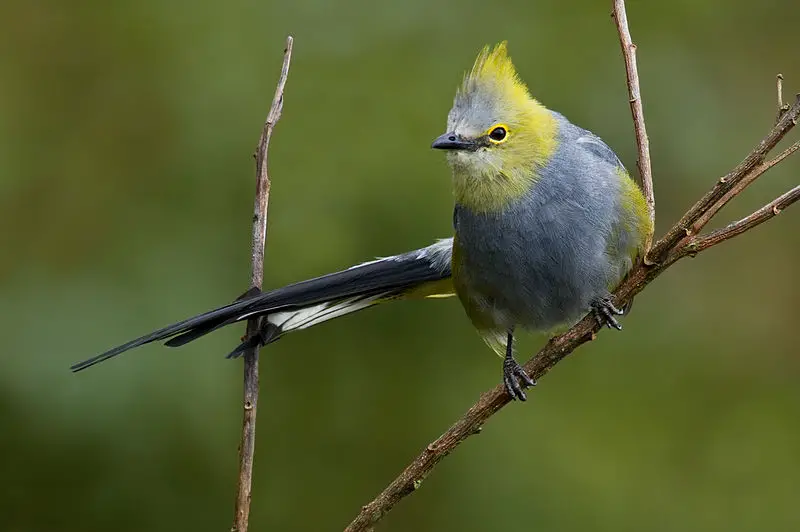
The Long-tailed silky-flycatcher is a small passerine bird found in the mountains of Costa Rica and western Panama, usually at altitudes between 1,850 m and timberline.
It has soft plumage with subtle yellowish feathers on its head, chestnut wings, and tail, and white underparts. This species weighs around 37 g, similar to thrushes in size.
Its habitat consists of mountain forests where breeding occurs from March to June when males use their distinctive long tails for courtship displays.
They feed primarily on insects such as flies but also take fruits when available.
The population is thought to be stable, although further research into this species’ ecology is needed before more accurate assessments can be made about its conservation status.
Scientific classification:
| Kingdom | Animalia |
| Phylum | Chordata |
| Class | Aves |
| Order | Passeriformes |
| Family | Ptiliogonatidae |
| Genus | Ptiliogonys |
| Species | P. caudatus |
Conclusion
The diverse avifauna of Costa Rica encompasses a rich tapestry of species, offering ornithologists, eco-tourists, and nature enthusiasts a plethora of unique experiences.
With its varied ecosystems, from lush rainforests to coastal mangroves and highland cloud forests, Costa Rica is a haven for over 900 bird species.
From the iconic Scarlet Macaw to the elusive Resplendent Quetzal, the country’s birds captivate with their vibrant plumage, melodious calls, and fascinating behaviors.
Preserving these habitats and protecting their inhabitants is paramount for ensuring the continued existence and enjoyment of Costa Rica’s remarkable birdlife for generations to come.